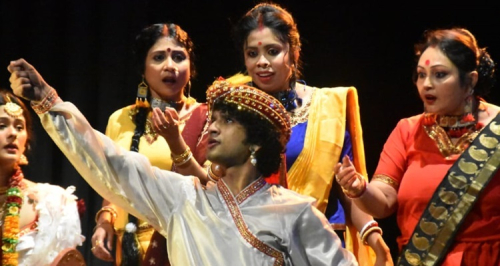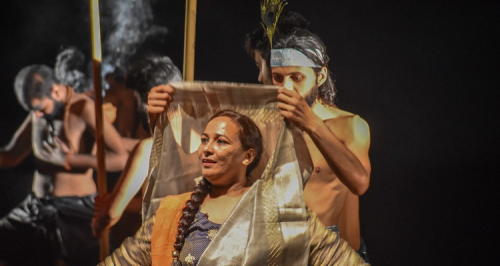Akshayambara
Gender is not an identity, its an expression. It is not a label but a symbol. Gender is not a boundary that shapes your thoughts and behaviour but a vast open area that lets you be whomever you want to be.
Akshayambhara is a play experimental in nature, that puts the audience in confrontation with the fundamental questions of gender.A woman is not always coy, but this does not imply that she can’t be. A man is not always is strong and sturdy, again not implying that he can’t be. Akshayambhara is an attempt to effectively shatter each shard of the glass which we use to fit in the characteristics associated with the 2 genders, male and female. The incorporation of the concept is as refreshing and unique as the concept itself.
3 stories are juxtaposed in the play each providing balance and contrast to the other.The stories are not played in a straight manner but there is intermixing of memory with emotions and actual episodes. “Thats how life is,” believes Sharanya Ramprakash, the Director and female actor in the play. How does a man who plays the character of Draupadi (Wife of the Pandavas) react to a woman who has been selected to play the character of Duryodhana (leader of the Kauravas)?
What arguments take place between Draupadi and Duryodhana during their Mela performance? Duryodhan and Draupadi are fighting their battles through their fiery speeches of ‘Dharma’ and ‘Adharma.’At the same time you see the flashbacks of a 14 year old boy who aspired to play ‘Abhimanyu,’ however it was destiny that landed him the character of ‘Subhadra’ instead.
Its a question of tradition versus aberration, and equality versus inequality, in the off stage scenario of the man and woman. The characters of Draupadi and Duryodhana brings you the answers that are being discussed off-stage.
Our thinking processes have been shaped in a manner which makes us segregate the good from the bad. The hero is good and the villain is evil. However that is not how things are in real life. Neither black nor white, there are shades of grey, white and blue in all of us. This is exactly how the play stands out from the other art representations that we have seen so far. There is no right, no wrong. You don’t sympathise with the character of one, but both. The play that has won accolades and nominations for its innovative sound design has used the talent of Yakshagana Kendra Gurus to bring out the ideal sound effect needed in each scene. Chende and Maddale are the musical instruments that are used in Yakshgana. A Bhagawatha sings the aalaps. It has been a creative and collaborative effort of the Director and Yakshagana Gurus to brainstorm for the ragas in the library. The violin had been used as an additional music instrument to bring out the surrealism of the memory sequences of the 14 year old boy. “Using violin was a conscious decision, however we did not play it witn the Yakshagana, it was played only during the memory sequences,” said Sharanya Ramprakash.
Sharanya Ramprakash excels in every scene especially the one where Draupadi is being disrobed. Prasad Cherkady effectively portrays the feminine nuances and the frustrations of the male performer as well. Audiences at the play appreciated the performance of both the actors.Ashish Dhamija said, “The setup was was very good and the dance performances as well.”Gayatri Khanna liked the choreography and the efforts put in by the male actor.
Who decides the virtue of Womanhood and who decides the authority of these decision makers? In the end audience is left thinking about these questions, questions that open a completely different arena.
— Samridhi Roy





Leave a reply